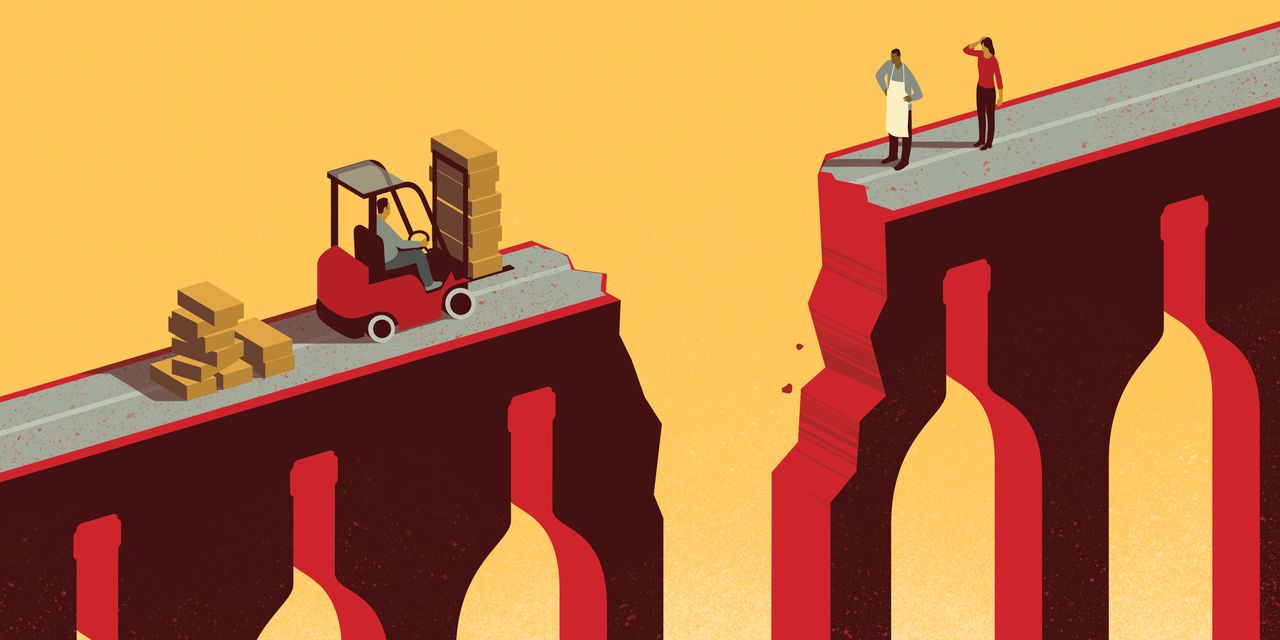
IF YOU WANT to buy a case of Veuve Clicquot Champagne at a state store in Pennsylvania, you’ll have to buy two bottles and wait until the next day to buy two more. And the next day another two, and so on and on—while supplies last. VC is one of the wines currently rationed by the Pennsylvania Liquor Control Board (PLCB) in response to the supply-chain disruption roiling the wine world right now.
SHARE YOUR THOUGHTS
Have you found it hard to find certain bottles of wine because of supply chain issues? Join the conversation below.
The supply chain for countless products is or has been disrupted—and that includes wine. There are ships languishing in ports and undelivered cases cramming warehouses to capacity, not to mention winemakers awaiting shipments of labels and bottles. The result: empty shelves at wine shops as well as the aforementioned rationing.
The pandemic played a role in the wine world’s supply chain woes; distributors struggled to keep up with the sharp increase in consumer demand and rolling state-by-state shutdowns crimped the labor market. The situation will get worse before it gets better according to the wine-industry experts I spoke with in recent weeks, though they didn’t all predict that Champagne will be scarce this holiday season.
Returning to those bottlenecked bottles of Veuve Clicquot in Pennsylvania: “We were notified by some vendors that what we had in stock was all that we’d have for the rest of the year,” said Shawn Kelly, press secretary of the PLCB, about the decision to limit sales. (He emphasized that he prefers the word “limit” over “ration.”)
“There may not only be empty shelves in wine stores but also a shortage of employees to ring up sales.”
I asked how long the limiting would last. “Indefinitely,” Mr. Kelly replied. As of this writing, Veuve Clicquot is one of 43 wine and spirits products under such limits at all PLCB-operated stores, and according to Mr. Kelly, that number may grow. (In Pennsylvania, wine and spirits sales are controlled by the state.)
Anticipating supply issues has changed the game for other retailers, too, including Phil Bernstein, general manager of MacArthur Beverage, a Washington, D.C., retailer founded in 1957. Mr. Bernstein has stocked up pre-emptively on certain wines—Champagne in particular. “We started hearing about these issues months ago,” he said.
As early as last spring, New York-based wine importer David Bowler saw suppliers struggling to keep up with demand, and he made the bold decision to draw a record amount on the business’s line of credit and buy as much wine as he could from many of his producers. “We began to order large amounts back in May and June. I wanted to have the goods here,” Mr. Bowler said. He essentially doubled his usual wine order—“a lot more wine, probably more than we’ve ever had.” So far the gamble has paid off: Bowler Wine has been setting new sales records each month, Mr. Bowler said.
Messrs. Bernstein and Bowler aren’t alone in stockpiling bottles. “There is an unprecedented volume of wine arriving in the U.S.,” noted Alexi Cashen, co-founder and CEO of Elenteny Imports, a wine and spirits distribution and logistics company based in New York. “This swelling of inventory has caused warehouses to refuse new product at their main [locations] and seek out emergency storage facilities.” But even if the wine gets to a warehouse, thanks to a shortage of trucks and truck drivers there is no telling when the wine will actually get delivered. Over and over again, Ms. Cashen has had to field the same question: “So my wine is in the warehouse—but when can I sell it?”
The process of getting wine to a warehouse starts with getting wine on a ship (or, less commonly, if the importer has a lot more money to spend, a plane). The ships need to be able to dock in a port on the East or West Coast. At the time of this writing, around 70 ships were waiting to dock in Los Angeles and Long Beach. The waiting costs money as well as time: Ocean carriers start to charge detention fees on containers out too long being delivered; demurrage fees apply to containers sitting at the port too long and typically increase over time. “We’re seeing containers waiting two to three weeks,” Ms. Cashen said.
Shipping rates have increased exponentially since the beginning of this year and are still rising according to Caroline Dewhirst, director of business development at Hillebrand North America. Her parent company, Hillebrand—the Mainz, Germany-based global freight-forwarding and logistics concern—is one of the largest players in global wine shipments. Ms. Dewhirst explained that the cost of shipping by sea to the West Coast of the U.S. from Asia rose by 380% this year over last based on a July 2021 versus July 2020 review; from South America, 185%. The cost of shipping from Europe to the East Coast of the U.S., meanwhile, rose by 110%. Prices for shipping by air, rail and truck have risen, too, if not quite so sharply.
Demand for items key to wine production and purveying—bottles, corks, labels—has spiked as well. According to Shawn Fitzgerald, chief marketing officer of Thomas (formerly known as the Thomas Register of American Manufacturers), there was a 77% increase in demand for wine boxes and a 172% increase in demand for wine bottles in September 2021 over the previous month. The situation has even led to “a rationing of sorts,” said Mr. Fitzgerald.
Scott DeFife, president of the Glass Packaging Institute, contends that in the case of wine bottles, scarcity of materials is not the problem—at least not domestically. “There is no shortage of glass in North America. We have all the raw materials we need,” he said. He did, however, concede that the same logistics problems cited above apply to bottles shipped from abroad: “There are absolutely import issues and supply-chain issues for everyone. If you are looking for a new supplier now, the bandwidth is tight.” It’s also much harder for wine producers to find special bottle types—especially if the bottle was once sourced in China or India, he noted. “It might take a quarter or more to get that sorted out,” said Mr. DeFife.
Aron Weinkauf, winemaker and vineyard manager at Spottswoode Winery in St. Helena, Calif., has had trouble finding the glass bottle the winery normally uses for its Spottswoode Sauvignon Blanc. “It’s a unique color with much smaller production volumes,” he explained. His supplier has told him that the bottle may not be available for some time. Mr. Weinkauf is currently “working on Plan B and C” for a new bottle, in a different color glass.
A bourbon supplier to Gary Fisch, proprietor of several Gary’s Wine & Marketplace stores in New Jersey and Napa, asked Mr. Fisch if he’d mind if a particular bottle of bourbon came in a PET bottle instead of glass. (PET is a type of polyester molded into plastic bottles.) Mr. Fisch responded, “PET is better than empty shelves.” Mr. Fisch is also contending with a labor shortage: He estimates he needs to hire at least 45 more staffers by the holidays, including cashiers, drivers, store managers, cheese managers and baristas. “In Napa we need…every job,” he wrote in an email.
What is normally the most profitable season of the year—called OND (for October-November-December) by retailers and wholesalers—is upon us. There may not only be empty shelves in wine stores but also a shortage of employees to ring up sales.
Here’s hoping there is Champagne enough for buyers and sellers alike—not to mention good reason to raise a toast—by the end of the year and hopefully sooner.
Write to Lettie at [email protected]
Copyright ©2021 Dow Jones & Company, Inc. All Rights Reserved. 87990cbe856818d5eddac44c7b1cdeb8








